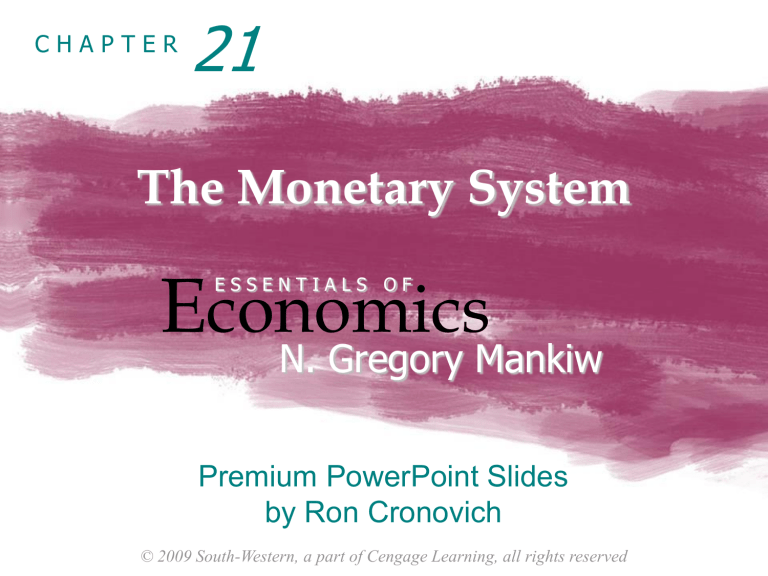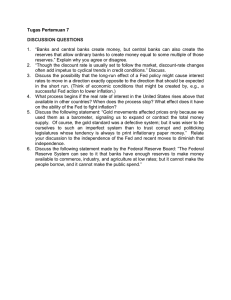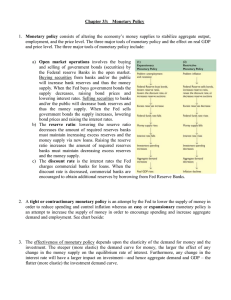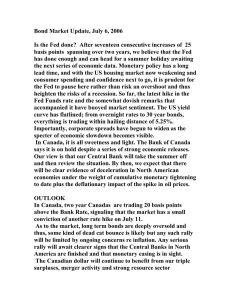
CHAPTER 21 The Monetary System Economics ESSENTIALS OF N. Gregory Mankiw Premium PowerPoint Slides by Ron Cronovich © 2009 South-Western, a part of Cengage Learning, all rights reserved In this chapter, look for the answers to these questions: What assets are considered “money”? What are the functions of money? The types of money? What is the Federal Reserve? What role do banks play in the monetary system? How do banks “create money”? How does the Federal Reserve control the money supply? 1 What Money Is and Why It’s Important Without money, trade would require barter, the exchange of one good or service for another. Every transaction would require a double coincidence of wants – the unlikely occurrence that two people each have a good the other wants. Most people would have to spend time searching for others to trade with – a huge waste of resources. This searching is unnecessary with money, the set of assets that people regularly use to buy g&s from other people. THE MONETARY SYSTEM 2 The 3 Functions of Money Medium of exchange: an item buyers give to sellers when they want to purchase g&s Unit of account: the yardstick people use to post prices and record debts Store of value: an item people can use to transfer purchasing power from the present to the future THE MONETARY SYSTEM 3 The 3 Kinds of Money Commodity money: takes the form of a commodity with intrinsic value Examples: gold coins, cigarettes in POW camps Bank Notes: Fiat money: money without intrinsic value, used as money because of govt decree Example: the U.S. dollar THE MONETARY SYSTEM 4 The Money Supply The money supply (or money stock): the quantity of money available in the economy What assets should be considered part of the money supply? Two candidates: Currency: the paper bills and coins in the hands of the (non-bank) public Demand deposits: balances in bank accounts that depositors can access on demand by writing a check THE MONETARY SYSTEM 5 Measures of the U.S. Money Supply M1: currency, demand deposits, traveler’s checks, and other checkable deposits. M1 = $1.4 trillion (June 2008) M2: everything in M1 plus savings deposits, small time deposits, money market mutual funds, and a few minor categories. M2 = $7.7 trillion (June 2008) The distinction between M1 and M2 will usually not matter when we talk about “the money supply” in this course. THE MONETARY SYSTEM 6 Central Banks & Monetary Policy Central bank: an institution that oversees the banking system and regulates the money supply Monetary policy: the setting of the money supply by policymakers in the central bank Federal Reserve (Fed): the central bank of the U.S. THE MONETARY SYSTEM 7 The Structure of the Fed The Federal Reserve System consists of: Board of Governors (7 members), located in Washington, DC 12 regional Fed banks, located around the U.S. Federal Open Market Ben S. Bernanke Chair of FOMC, Feb 2006 – present Committee (FOMC), includes the Bd of Govs and presidents of some of the regional Fed banks The FOMC decides monetary policy. THE MONETARY SYSTEM 8 The Structure of the BSP The Bangko Sentral ng Pilipinas consists of: Board of Governors (7 members), located in Metro Manila. 3 regional Fed banks, located around the La Union, Cebu City and Davao City. The Advisory Committee BENJAMIN E. DIOKNO, Ph.D. Governor of BSP, Feb 2016 – present deliberate, discuss and make recommendations on monetary policy to the Monetary Board. THE MONETARY SYSTEM 9 Bank Reserves In a fractional reserve banking system, banks keep a fraction of deposits as reserves and use the rest to make loans. The Fed establishes reserve requirements, regulations on the minimum amount of reserves that banks must hold against deposits. Banks may hold more than this minimum amount if they choose. The reserve ratio, R = fraction of deposits that banks hold as reserves = total reserves as a percentage of total deposits THE MONETARY SYSTEM 10 The Fed’s 3 Tools of Monetary Control 1. Open-Market Operations (OMOs): the purchase and sale of U.S. government bonds by the Fed. To increase money supply, Fed buys govt bonds, paying with new dollars. …which are deposited in banks, increasing reserves …which banks use to make loans, causing the money supply to expand. To reduce money supply, Fed sells govt bonds, taking dollars out of circulation, and the process works in reverse. THE MONETARY SYSTEM 11 The Fed’s 3 Tools of Monetary Control 1. Open-Market Operations (OMOs): the purchase and sale of U.S. government bonds by the Fed. OMOs are easy to conduct, and are the Fed’s monetary policy tool of choice. THE MONETARY SYSTEM 12 The Fed’s 3 Tools of Monetary Control 2. Reserve Requirements (RR): affect how much money banks can create by making loans. To increase money supply, Fed reduces RR. Banks make more loans from each dollar of reserves, which increases money multiplier and money supply. To reduce money supply, Fed raises RR, and the process works in reverse. Fed rarely uses reserve requirements to control money supply: Frequent changes would disrupt banking. THE MONETARY SYSTEM 13 The Fed’s 3 Tools of Monetary Control 3. The Discount Rate: the interest rate on loans the Fed makes to banks When banks are running low on reserves, they may borrow reserves from the Fed. To increase money supply, Fed can lower discount rate, which encourages banks to borrow more reserves from Fed. Banks can then make more loans, which increases the money supply. To reduce money supply, Fed can raise discount rate. THE MONETARY SYSTEM 14 The Fed’s 3 Tools of Monetary Control 3. The Discount Rate: the interest rate on loans the Fed makes to banks The Fed uses discount lending to provide extra liquidity when financial institutions are in trouble, e.g. after the Oct. 1987 stock market crash. If no crisis, Fed rarely uses discount lending – Fed is a “lender of last resort.” THE MONETARY SYSTEM 15 The Federal Funds Rate On any given day, banks with insufficient reserves can borrow from banks with excess reserves. The interest rate on these loans is the federal funds rate. The FOMC uses OMOs to target the fed funds rate. Many interest rates are highly correlated, so changes in the fed funds rate cause changes in other rates and have a big impact in the economy. THE MONETARY SYSTEM 16 The Fed Funds Rate and Other Rates, 1970-2008 Fed funds 20 prime 3-month Tbill 15 (%) mortgage 10 5 0 1970 1975 1980 1985 1990 1995 2000 2005 Problems Controlling the Money Supply If households hold more of their money as currency, banks have fewer reserves, make fewer loans, and money supply falls. If banks hold more reserves than required, they make fewer loans, and money supply falls. Yet, Fed can compensate for household and bank behavior to retain fairly precise control over the money supply. THE MONETARY SYSTEM 18 Bank Runs and the Money Supply During 1929-1933, a wave of bank runs and bank closings caused money supply to fall 28%. Many economists believe this contributed to the severity of the Great Depression. Since then, federal deposit insurance has helped prevent bank runs in the U.S. In the U.K., though, Northern Rock bank experienced a classic bank run in 2007 and was eventually taken over by the British government. THE MONETARY SYSTEM 19 CHAPTER SUMMARY Money includes currency and various types of bank deposits. The Federal Reserve is the central bank of the U.S., is responsible for regulating the monetary system. The Fed controls the money supply mainly through open-market operations. Purchasing govt bonds increases the money supply, selling govt bonds decreases it. 20 CHAPTER SUMMARY In a fractional reserve banking system, banks create money when they make loans. Bank reserves have a multiplier effect on the money supply. 21








